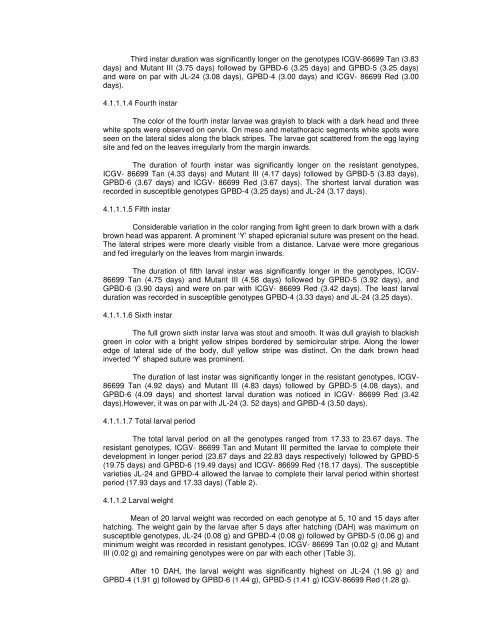screening elite genotypes and ipm of defoliators in groundnut
screening elite genotypes and ipm of defoliators in groundnut
screening elite genotypes and ipm of defoliators in groundnut
Create successful ePaper yourself
Turn your PDF publications into a flip-book with our unique Google optimized e-Paper software.
Third <strong>in</strong>star duration was significantly longer on the <strong>genotypes</strong> ICGV-86699 Tan (3.83<br />
days) <strong>and</strong> Mutant III (3.75 days) followed by GPBD-6 (3.25 days) <strong>and</strong> GPBD-5 (3.25 days)<br />
<strong>and</strong> were on par with JL-24 (3.08 days), GPBD-4 (3.00 days) <strong>and</strong> ICGV- 86699 Red (3.00<br />
days).<br />
4.1.1.1.4 Fourth <strong>in</strong>star<br />
The color <strong>of</strong> the fourth <strong>in</strong>star larvae was grayish to black with a dark head <strong>and</strong> three<br />
white spots were observed on cervix. On meso <strong>and</strong> metathoracic segments white spots were<br />
seen on the lateral sides along the black stripes. The larvae got scattered from the egg lay<strong>in</strong>g<br />
site <strong>and</strong> fed on the leaves irregularly from the marg<strong>in</strong> <strong>in</strong>wards.<br />
The duration <strong>of</strong> fourth <strong>in</strong>star was significantly longer on the resistant <strong>genotypes</strong>,<br />
ICGV- 86699 Tan (4.33 days) <strong>and</strong> Mutant III (4.17 days) followed by GPBD-5 (3.83 days),<br />
GPBD-6 (3.67 days) <strong>and</strong> ICGV- 86699 Red (3.67 days). The shortest larval duration was<br />
recorded <strong>in</strong> susceptible <strong>genotypes</strong> GPBD-4 (3.25 days) <strong>and</strong> JL-24 (3.17 days).<br />
4.1.1.1.5 Fifth <strong>in</strong>star<br />
Considerable variation <strong>in</strong> the color rang<strong>in</strong>g from light green to dark brown with a dark<br />
brown head was apparent. A prom<strong>in</strong>ent ‘Y’ shaped epicranial suture was present on the head.<br />
The lateral stripes were more clearly visible from a distance. Larvae were more gregarious<br />
<strong>and</strong> fed irregularly on the leaves from marg<strong>in</strong> <strong>in</strong>wards.<br />
The duration <strong>of</strong> fifth larval <strong>in</strong>star was significantly longer <strong>in</strong> the <strong>genotypes</strong>, ICGV-<br />
86699 Tan (4.75 days) <strong>and</strong> Mutant III (4.58 days) followed by GPBD-5 (3.92 days), <strong>and</strong><br />
GPBD-6 (3.90 days) <strong>and</strong> were on par with ICGV- 86699 Red (3.42 days). The least larval<br />
duration was recorded <strong>in</strong> susceptible <strong>genotypes</strong> GPBD-4 (3.33 days) <strong>and</strong> JL-24 (3.25 days).<br />
4.1.1.1.6 Sixth <strong>in</strong>star<br />
The full grown sixth <strong>in</strong>star larva was stout <strong>and</strong> smooth. It was dull grayish to blackish<br />
green <strong>in</strong> color with a bright yellow stripes bordered by semicircular stripe. Along the lower<br />
edge <strong>of</strong> lateral side <strong>of</strong> the body, dull yellow stripe was dist<strong>in</strong>ct. On the dark brown head<br />
<strong>in</strong>verted ‘Y’ shaped suture was prom<strong>in</strong>ent.<br />
The duration <strong>of</strong> last <strong>in</strong>star was significantly longer <strong>in</strong> the resistant <strong>genotypes</strong>, ICGV-<br />
86699 Tan (4.92 days) <strong>and</strong> Mutant III (4.83 days) followed by GPBD-5 (4.08 days), <strong>and</strong><br />
GPBD-6 (4.09 days) <strong>and</strong> shortest larval duration was noticed <strong>in</strong> ICGV- 86699 Red (3.42<br />
days).However, it was on par with JL-24 (3. 52 days) <strong>and</strong> GPBD-4 (3.50 days).<br />
4.1.1.1.7 Total larval period<br />
The total larval period on all the <strong>genotypes</strong> ranged from 17.33 to 23.67 days. The<br />
resistant <strong>genotypes</strong>, ICGV- 86699 Tan <strong>and</strong> Mutant III permitted the larvae to complete their<br />
development <strong>in</strong> longer period (23.67 days <strong>and</strong> 22.83 days respectively) followed by GPBD-5<br />
(19.75 days) <strong>and</strong> GPBD-6 (19.49 days) <strong>and</strong> ICGV- 86699 Red (18.17 days). The susceptible<br />
varieties JL-24 <strong>and</strong> GPBD-4 allowed the larvae to complete their larval period with<strong>in</strong> shortest<br />
period (17.93 days <strong>and</strong> 17.33 days) (Table 2).<br />
4.1.1.2 Larval weight<br />
Mean <strong>of</strong> 20 larval weight was recorded on each genotype at 5, 10 <strong>and</strong> 15 days after<br />
hatch<strong>in</strong>g. The weight ga<strong>in</strong> by the larvae after 5 days after hatch<strong>in</strong>g (DAH) was maximum on<br />
susceptible <strong>genotypes</strong>, JL-24 (0.08 g) <strong>and</strong> GPBD-4 (0.08 g) followed by GPBD-5 (0.06 g) <strong>and</strong><br />
m<strong>in</strong>imum weight was recorded <strong>in</strong> resistant <strong>genotypes</strong>, ICGV- 86699 Tan (0.02 g) <strong>and</strong> Mutant<br />
III (0.02 g) <strong>and</strong> rema<strong>in</strong><strong>in</strong>g <strong>genotypes</strong> were on par with each other (Table 3).<br />
After 10 DAH, the larval weight was significantly highest on JL-24 (1.98 g) <strong>and</strong><br />
GPBD-4 (1.91 g) followed by GPBD-6 (1.44 g), GPBD-5 (1.41 g) ICGV-86699 Red (1.28 g).
















